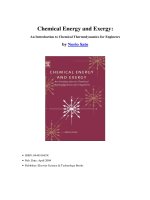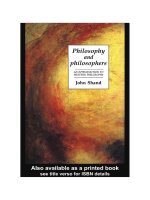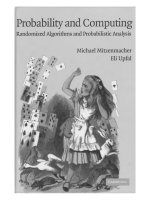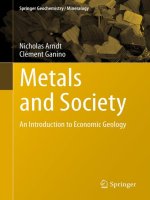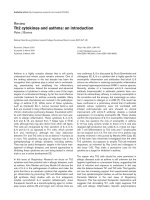Cultural heritage and tourism: An introduction
Bạn đang xem bản rút gọn của tài liệu. Xem và tải ngay bản đầy đủ của tài liệu tại đây (117.92 KB, 26 trang )
1
Heritage Tourism
Hanoi University
Cultural heritage and tourism:
An introduction
2
Learning Objectives
Identify some of the earliest manifestations of
heritage tourism
Define context of cultural heritage and tourism
Understand the meaning of heritage and what it
entails
Understand the characteristics of cultural
tourism and heritage tourism
Know the spatial perspectives of cultural
heritage and tourism
Learn 4 main underlying principles of
cultural/heritage tourism and its key issues
Gain knowledge about trend in Heritage Tourism
3
Looking at the past …
Pilgrimage: one of the earliest forms of heritage
tourism
Noble classes traveling to view sites that were
already old
Grand Tour (1600s – mid 1800s): important phase
1841: Experiences of Thomas Cook
Nowadays: heritage properties and living cultures
are among the most popular attractions
4
Context for Cultural Heritage
Tourism
Tourism
Commercial, profit making activity, private sector
orientated
Involves the consumption of experiences
Entertainment
Demand driven activity, difficult to control, for tourists
from “away”
International/National Political Bodies
(WTO/WTTC/NTO’s) promote development of tourism
5
Context for Cultural Heritage
Tourism
Heritage
Not commercial, broad social goals, not for profit
activity, public sector orientated
Involves conservation and protection of cultural
assets
Promotes value of culture to communities, local
residents as users
International/National Political Bodies
(ICOMOS/ICOM/UNESCO, National and Provincial
Museums, Archives, Parks) promote conservation of
culture
6
Heritage tourism: what is it?
Simply people visiting heritage places or
viewing historical resources
Personal connection to the objects or
places being viewed
Encompasses a multitude of motives,
resources and experiences and is different
for every individual and every place visited
7
Intangible heritage
Casual heritage visitors
The built past
Contemporary culture
Urban settings
Personal cultural growth
Serious heritage visitors
Rural settings
All motives and experiences
Tangible heritage
Heritage Tourism
Heritage Tourism
8
Defining Cultural Heritage Tourism
Wide variety of definitions of cultural tourism
“Such is the range of possible uses of the term, that no single
widely accepted definition of cultural tourism has yet emerged”
(Richards, 1993)
“Heritage tourism includes a variety of experiences focused on
natural, cultural and historical resources” (CTC, 1997)
“Cultural tourism can be defined as the art of participating in
another culture, of relation to people and places which
demonstrate a strong sense of their own identity (Derrett, 1999)
Cultural tourism is “an immersion in the natural history, human
heritage, the arts and philosophy, and the institutions of another
region or country” (Koster, 1989)
Visits by persons from outside the host community motivated
wholly or in part by interest in the historic, artistic, scientific or
lifestyle/heritage offerings of a community, region, group or
institution (Lord, 1993)
Heritage tourism is “tourism which is based on heritage where
heritage is the core of the product that is offered and heritage is
the main motivating factor for the consumer” (Swarbrooke,
1993).
9
Common Elements in Definitions
Four broad categories of definitions:
tourism derived – places cultural tourism with broad
tourism framework, i.e. a form of special interest
tourism, tourism experience motivated by heritage
interests,
motivational – idea that cultural tourists are motivated
to travel for different reasons than other tourists
experiential – element of experiencing or having
contact with other cultures and heritage
operational – defined by participation in or “visits”
more than by motivations, purpose or depth of
experience
10
Heritage Sector
Museums and galleries
Historic parks and sites
Historic buildings and houses
Natural heritage and countryside
Heritage attractions, centers
Traditional festivals and events
Language, literature, music and art
Traditional lifestyles including food, drink and
sport
11
Heritage tourism vs. Cultural tourism
Heritage
tourism
Cultural
Tourism
Overlap
12
Two separate but related phenomena
Content is the same while the context is different
None of these elements differs significantly from
the meaning of heritage tourism
Both terms will be used interchangeably
Heritage tourism vs. Cultural tourism
13
Spatial forms of heritage
resources
Heritage attractions can be divided into:
Physical - spatial characteristics
Scale
Location setting
Others
14
Spatial forms of heritage
resources
Physical - spatial characteristics
Point resources: stand-alone, individual sites in
small space
Linear attractions: linear properties, link point
resources and guide users along a specific path
Areas: larger resources that usually encompass
many smaller attractions
15
Spatial forms of heritage
resources
Scale
Personal
World
National Local
Overlapping
Heritage
16
Spatial forms of heritage
resources
Scale
Global:
Sites and monuments that are well-known word wide
Symbolize certain regions, countries, groups or a
period of time that have impacted the entire world
National:
Sites associated with the development of nation-
states
Appeal primarily to citizens of the countries and
foreign visitors as well
17
Scale
Local/Regional
Promoting regional/local buildings or marking
locations as tourist attractions
Little allure for outsiders but can be important
places to visit for locals
Potential to stir a sense of nostalgia or
appreciation for the past in the local community
Individual/personal
Most meaningful personally to each individual.
Spatial forms of heritage
resources
18
Location setting
Urban setting:
Notion of “tourist-historic cities”
Rural setting:
Natural heritage is a vital part of the rural product
Notion of “countryside-idyll”
Others
Spatial distribution of different types of heritage
attractions
Age and antiquity
Magnitude and reputation of heritage places
Principle of clustering
Spatial forms of heritage resources
19
Underlying principles of cultural
tourism
The nature of tourism
Tourism is a commercial activity
Tourism involves the consumption of
experiences
Tourism is entertainment
Tourism is a demand-driven activity that is
difficult to control
20
Underlying principles of cultural
tourism
Attractions drive tourism
Not all tourism attractions are equal
Cultural heritage attractions are part of
tourism
Not all cultural assets are cultural tourist
attractions
21
Underlying principles of cultural
tourism
Factors influencing visitation levels
Access and proximity dictate the potential
number of visitors
Time availability influences the quality and
depth of experience sought
22
Underlying principles of cultural
tourism
Tourist behavior
The tourist experience must be controlled to
control the actions of the tourist
Tourists want to controlled experiences
The more mainstream the market, the greater
the need for user-friendly tourism products
23
Underlying principles of cultural
tourism
Cultural tourist
Not all cultural tourists are alike
Cultural tourism products may be challenging
and confronting but not intimidating or
accusatory
Tourists want “authenticity” but not
necessarily reality
24
Key issues in Cultural Heritage
Tourism
Key issue as “finding a balance between
tourism and cultural heritage management”.
Consumption of extrinsic values by tourists and
conservation of intrinsic values by cultural heritage
managers
Stumbling block is operation in parallel of T & CHM
rather than in partnership
Potential for partnerships in overcoming conflicts
between T and CHM
25
Key Issue
Historic lack of understanding of the roles
of each sector (T and CHM) – managers
from differing academic backgrounds
(tourism = business and marketing
degrees, CHM = social science, arts,
heritage management degrees)

